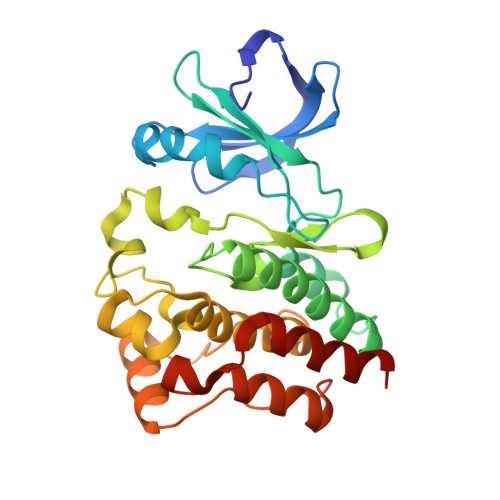Selectively targeting an inactive conformation of interleukin-2-inducible T-cell kinase by allosteric inhibitors.
Han, S., Czerwinski, R.M., Caspers, N.L., Limburg, D.C., Ding, W., Wang, H., Ohren, J.F., Rajamohan, F., McLellan, T.J., Unwalla, R., Choi, C., Parikh, M.D., Seth, N., Edmonds, J., Phillips, C., Shakya, S., Li, X., Spaulding, V., Hughes, S., Cook, A., Robinson, C., Mathias, J.P., Navratilova, I., Medley, Q.G., Anderson, D.R., Kurumbail, R.G., Aulabaugh, A.(2014) Biochem J 460: 211-222
- PubMed: 24593284
- DOI: https://doi.org/10.1042/BJ20131139
- Primary Citation of Related Structures:
4M0Y, 4M0Z, 4M12, 4M13, 4M14, 4M15 - PubMed Abstract:
ITK (interleukin-2-inducible T-cell kinase) is a critical component of signal transduction in T-cells and has a well-validated role in their proliferation, cytokine release and chemotaxis. ITK is an attractive target for the treatment of T-cell-mediated inflammatory diseases. In the present study we describe the discovery of kinase inhibitors that preferentially bind to an allosteric pocket of ITK. The novel ITK allosteric site was characterized by NMR, surface plasmon resonance, isothermal titration calorimetry, enzymology and X-ray crystallography. Initial screening hits bound to both the allosteric pocket and the ATP site. Successful lead optimization was achieved by improving the contribution of the allosteric component to the overall inhibition. NMR competition experiments demonstrated that the dual-site binders showed higher affinity for the allosteric site compared with the ATP site. Moreover, an optimized inhibitor displayed non-competitive inhibition with respect to ATP as shown by steady-state enzyme kinetics. The activity of the isolated kinase domain and auto-activation of the full-length enzyme were inhibited with similar potency. However, inhibition of the activated full-length enzyme was weaker, presumably because the allosteric site is altered when ITK becomes activated. An optimized lead showed exquisite kinome selectivity and is efficacious in human whole blood and proximal cell-based assays.
- *Pfizer Worldwide Research, Eastern Point Road, Groton, CT 06340, U.S.A.
Organizational Affiliation:

















